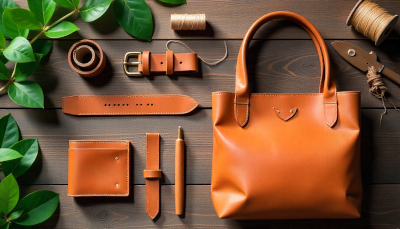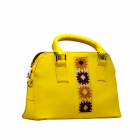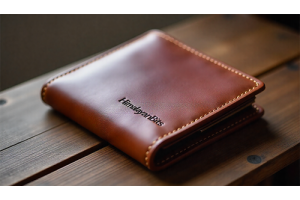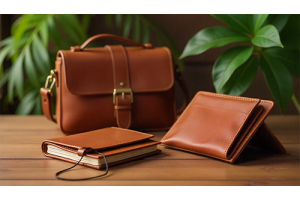Sustainable Style Starts with Vegetable-Tanned Leather

Sustainable Style Starts with Vegetable-Tanned Leather
In a world of fast fashion and synthetic materials, vegetable-tanned leather stands out as a timeless, sustainable choice. Crafted using natural tannins from plants, bark, and fruits, this traditional tanning process creates leather that’s not only durable but also kind to the environment. Each piece tells its own story, aging beautifully with use and developing a rich patina that reflects your journey. Choosing vegetable-tanned leather means embracing quality, craftsmanship, and eco-conscious style that lasts for years—not seasons.
1.Introduction – Sustainable Style Starts with Vegetable-Tanned Leather
In a world dominated by fast fashion, vegetable-tanned leather stands out for its authenticity, sustainability, and timeless charm. This traditional tanning method uses natural tannins from plants, bark, and fruits—avoiding harmful chemicals and reducing environmental impact. Each piece ages beautifully, gaining character and depth over time. Choosing vegetable-tanned leather isn’t just about style; it’s about embracing quality, durability, and a conscious approach to fashion that respects both people and the planet.
- Vegetable-tanned leather represents timeless style and sustainable craftsmanship.
- It’s made using natural tannins from plants, bark, and fruits instead of harmful chemicals.
- This eco-friendly process reduces environmental impact and supports traditional methods.
- Each piece develops a unique patina over time, adding depth and character.
- Choosing vegetable-tanned leather reflects a commitment to quality, durability, and conscious living.
Tip
FStart with a strong statement that connects sustainability and style. Readers should immediately feel that choosing vegetable-tanned leather is both a fashionable and responsible decision. Use sensory or emotional language — like “natural,” “timeless,” or “crafted with care” — to make the introduction engaging and memorable.
2.What Is Vegetable-Tanned Leather
Vegetable-tanned leather is one of the oldest and most authentic forms of leather tanning — a process that uses natural tannins extracted from plants, bark, leaves, and fruits. Unlike modern chrome tanning, which depends on chemicals for speed and uniformity, vegetable tanning is slow, careful, and deeply traditional. It transforms raw hides into durable leather through an eco-conscious process that values time, nature, and craftsmanship. This tanning method takes several weeks, allowing the hides to slowly absorb natural tannins in large wooden drums or pits. The result is leather that feels firm yet flexible, has a distinctive earthy aroma, and displays a warm, natural color tone that can’t be replicated by synthetic methods. One of the most remarkable qualities of vegetable-tanned leather is its patina — a soft sheen and darkening effect that develops over time. Each scratch, fold, and mark becomes part of the leather’s story, making every piece unique. This natural aging process gives the leather depth, personality, and timeless charm. From a sustainability perspective, vegetable tanning is a cleaner, biodegradable process. Since it uses organic materials, it produces minimal environmental waste and avoids harmful chemical runoff. It also supports small-scale tanneries and artisans who preserve traditional leatherworking skills passed down through generations. Vegetable-tanned leather is highly valued in handmade goods such as belts, wallets, bags, and shoes — products designed to last for years, not seasons. It represents a conscious shift toward slow fashion, where quality, durability, and ethical production matter more than fast trends. In short, vegetable-tanned leather is not just a material — it’s a philosophy. It combines natural beauty, environmental respect, and timeless craftsmanship, making it the perfect choice for anyone who values sustainable style and lasting quality.
What Is Vegetable-Tanned Leather
- Vegetable-tanned leather is a natural and eco-friendly type of leather made using tannins from plants, bark, and fruits.
- This traditional method has been used for centuries and is known for its environmentally safe process compared to chemical tanning.
- The tanning process takes several weeks, allowing the leather to develop a rich texture, natural scent, and deep color tone.
- Over time, it forms a beautiful patina, giving each piece a unique character and timeless appeal.
- Choosing vegetable-tanned leather supports sustainability, traditional craftsmanship, and long-lasting quality.
Introduction for benefits
A well-designed leather bag does more than look good—it makes everyday life easier. Combining style with practicality, it keeps your essentials organized, offers lasting durability, and provides comfort while carrying. These benefits show how thoughtful craftsmanship turns a simple accessory into a versatile, long-lasting companion.
Introduction – Benefits and Advantages of Style Meets Functionality
- Eco-friendly process that uses natural plant-based tannins instead of harmful chemicals.
- Highly durable and strong, designed to last for years and improve with age.
- Develops a natural patina over time, giving each piece a unique character.
- Non-toxic and safe for both artisans and the environment.
- Supports traditional craftsmanship and promotes sustainable fashion.
The Craftsmanship Behind the Process
- Vegetable tanning is a slow and careful process that can take several weeks to complete.
- Skilled artisans hand-select quality hides to ensure strength, texture, and natural beauty.
- Hides are soaked in large wooden drums or pits filled with plant-based tannins.
- The leather absorbs these natural extracts gradually, gaining its distinct color and firmness.
- Each step is done by hand, reflecting traditional methods passed down through generations.
3. Key Benefits of Vegetable-Tanned Leather
Vegetable-tanned leather offers more than just visual appeal — it’s known for its durability, natural beauty, and eco-friendly production. Every piece of leather made through this process reflects time, care, and sustainable craftsmanship. Here are some of the key benefits that make it stand out from chemically tanned alternatives:
- Made through a natural tanning process that minimizes chemical waste and supports a cleaner environment.
- Highly durable and long-lasting, designed to improve in texture and flexibility with regular use.
- Develops a beautiful patina over time, giving each piece a distinctive look and character.
- Non-toxic and hypoallergenic, making it safe for both artisans and end users.
- Promotes sustainable craftsmanship by preserving traditional tanning techniques and supporting local artisans.
- Breathable and comfortable to use, allowing air to pass through naturally for better wearability.
- Fully biodegradable, reducing long-term environmental impact and promoting responsible production.
| No. | Key Benefit | Description |
|---|---|---|
| 1 | Eco-Friendly Process | Made using natural plant-based tannins instead of harmful chemicals, reducing pollution and chemical waste. |
| 2 | Durability and Strength | Designed to last for years; it becomes softer, more flexible, and more comfortable with time. |
| 3 | Natural Patina | Ages beautifully, developing a rich color and unique character that reflects personal use. |
| 4 | Safe and Non-Toxic | Free from synthetic additives, making it safer for artisans, consumers, and the environment. |
| 5 | Supports Traditional Craftsmanship | Helps preserve centuries-old tanning skills and promotes sustainable, ethical production. |
| 6 | Breathable and Comfortable | Allows air to pass naturally through the leather, enhancing comfort and wearability. |
| 7 | Biodegradable | Naturally decomposes at the end of its life cycle, minimizing long-term environmental impact. |
4. The Craftsmanship Behind the Process
Creating vegetable-tanned leather is not just a production routine — it’s an art form that reflects patience, precision, and respect for tradition. Every piece begins with the careful selection of natural hides, chosen for their quality and strength. Skilled artisans rely on generations-old methods, using only plant-based tannins to transform raw hides into rich, durable leather. This process is slow, deliberate, and deeply sustainable, often taking weeks to complete. Unlike modern chemical tanning, which prioritizes speed, vegetable tanning celebrates the natural rhythm of craftsmanship — allowing the leather to breathe, develop unique tones, and form its own character over time. The result is a material that embodies both artistry and authenticity, making every finished product a testament to the craftsman’s dedication and the timeless beauty of natural materials.
- Careful selection of high-quality natural hides for strength and longevity.
- Use of natural plant-based tannins from bark, leaves, and fruit.
- Time-intensive tanning process that can take several weeks to complete.
- Skilled artisans monitor each stage to maintain consistency and natural color.
- Resulting leather develops a rich patina and unique texture over time.
| No. | Stage | Description |
|---|---|---|
| 1 | Selection of Hides | Artisans carefully choose high-quality raw hides that are free from major imperfections, ensuring durability and beauty. |
| 2 | Preparation and Cleaning | The hides are cleaned and soaked to remove impurities, allowing them to absorb tannins evenly during tanning. |
| 3 | Tanning Process | Hides are placed in large wooden drums or pits containing plant-based tannins, where they slowly absorb natural color and strength over several weeks. |
| 4 | Drying and Conditioning | After tanning, the leather is gently dried and treated with natural oils to enhance flexibility and maintain texture. |
| 5 | Finishing Touches | Each piece is hand-finished, polished, and inspected to highlight its natural grain and ensure a premium, long-lasting quality. |
5. Why It’s a Sustainable Choice
Vegetable-tanned leather stands apart as one of the most environmentally responsible materials in the fashion and craft industries. Its production relies on natural ingredients, thoughtful processes, and long-lasting quality rather than harmful shortcuts. Each piece is created with respect for nature, using plant-based tannins that minimize pollution and waste. This traditional method not only supports ethical craftsmanship but also promotes conscious consumer choices, making it a true investment in sustainable style and slow fashion.
- Uses natural tannins from plants instead of harsh synthetic chemicals.
- Produces biodegradable leather that minimizes waste and pollution.
- Encourages ethical manufacturing and supports artisan communities.
- Offers exceptional durability, reducing the need for frequent replacements.
- Preserves heritage tanning techniques rooted in environmental care.
| Aspect | Why It’s Sustainable |
|---|---|
| Natural Ingredients | Uses tannins from plants such as bark, leaves, and fruits instead of synthetic chemicals. |
| Eco-Friendly Production | Minimizes water pollution and chemical waste, protecting ecosystems. |
| Biodegradability | Fully decomposes over time without releasing harmful substances. |
| Ethical Craftsmanship | Supports local artisans and small-scale workshops that prioritize quality and tradition. |
| Durability | Creates long-lasting products that reduce the environmental impact of fast fashion. |
Conclusion – Timeless Elegance Meets Sustainability
Vegetable-tanned leather beautifully blends timeless elegance with conscious craftsmanship. It’s more than just a material — it’s a reflection of patience, skill, and respect for the environment. Every piece crafted through this traditional process tells a story of natural beauty, durability, and care for the planet. By choosing vegetable-tanned leather, you’re not only embracing authentic style but also supporting sustainable practices that value quality over convenience. It’s a reminder that true luxury doesn’t fade with time — it grows richer, stronger, and more meaningful with every use.
FAQs
1. What makes vegetable-tanned leather sustainable?
It’s made using natural tannins from plants instead of synthetic chemicals, which makes the process eco-friendly and the leather biodegradable.
2. How long does vegetable-tanned leather last?
With proper care, vegetable-tanned leather can last for decades. It becomes softer and develops a beautiful patina that adds character over time.
3. Does vegetable-tanned leather require special maintenance?
Yes, it should be kept away from excessive moisture and conditioned regularly with natural leather balm to maintain its texture and shine.
4. Is vegetable-tanned leather more expensive than other types?
It often costs more because of its slow, traditional tanning process, but its durability and eco-friendly qualities make it a long-term investment.
5. Can vegetable-tanned leather be used for all kinds of products?
Absolutely. It’s commonly used for bags, belts, wallets, and shoes — offering both strength and natural beauty in every design.










